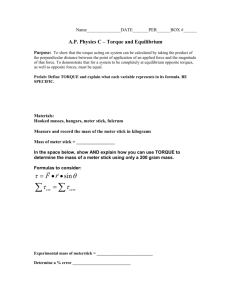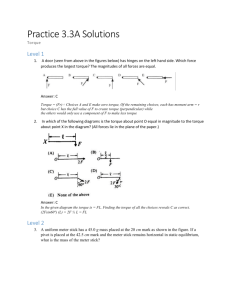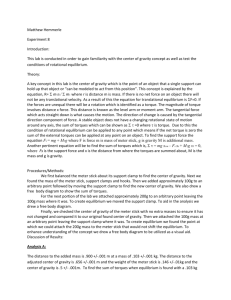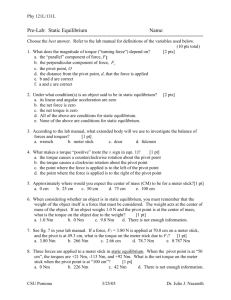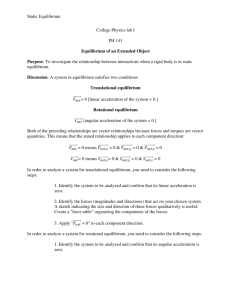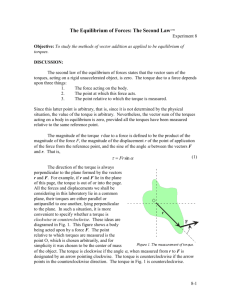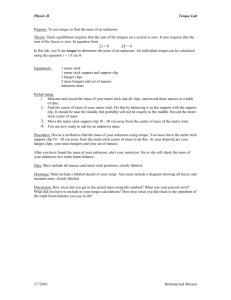Physics 244
advertisement
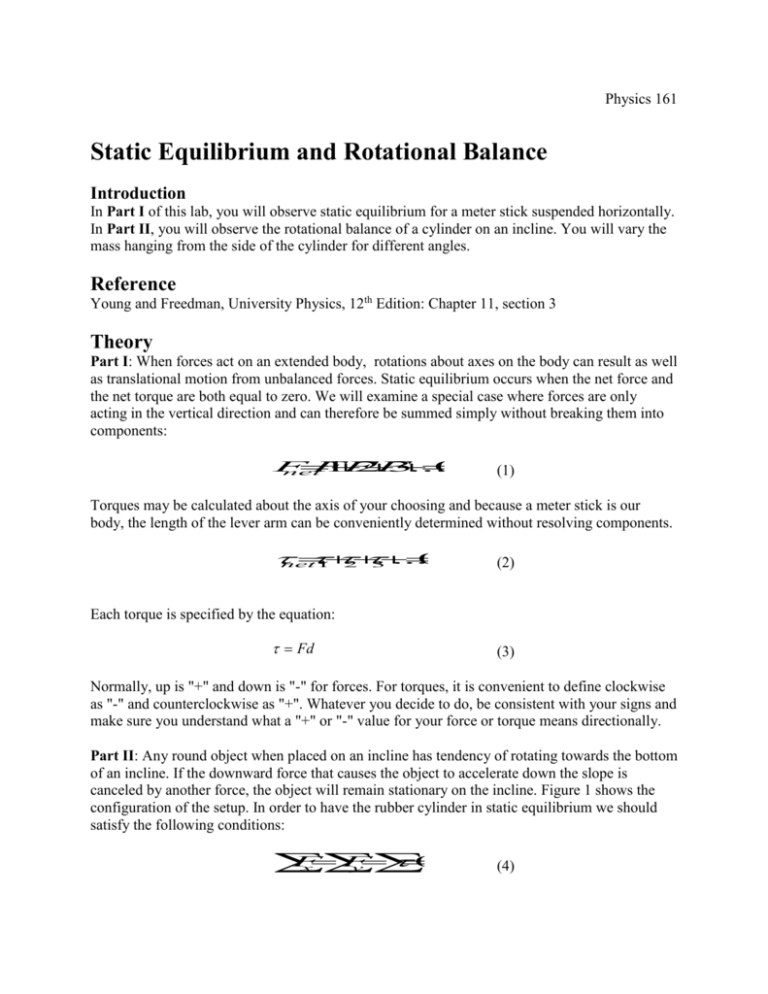
Physics 161 Static Equilibrium and Rotational Balance Introduction In Part I of this lab, you will observe static equilibrium for a meter stick suspended horizontally. In Part II, you will observe the rotational balance of a cylinder on an incline. You will vary the mass hanging from the side of the cylinder for different angles. Reference Young and Freedman, University Physics, 12th Edition: Chapter 11, section 3 Theory Part I: When forces act on an extended body, rotations about axes on the body can result as well as translational motion from unbalanced forces. Static equilibrium occurs when the net force and the net torque are both equal to zero. We will examine a special case where forces are only acting in the vertical direction and can therefore be summed simply without breaking them into components: F F 1 F 2 F 3 ... 0 net (1) Torques may be calculated about the axis of your choosing and because a meter stick is our body, the length of the lever arm can be conveniently determined without resolving components. ... 0 net 1 2 3 (2) Each torque is specified by the equation: Fd (3) Normally, up is "+" and down is "-" for forces. For torques, it is convenient to define clockwise as "-" and counterclockwise as "+". Whatever you decide to do, be consistent with your signs and make sure you understand what a "+" or "-" value for your force or torque means directionally. Part II: Any round object when placed on an incline has tendency of rotating towards the bottom of an incline. If the downward force that causes the object to accelerate down the slope is canceled by another force, the object will remain stationary on the incline. Figure 1 shows the configuration of the setup. In order to have the rubber cylinder in static equilibrium we should satisfy the following conditions: F F 0 x y (4) Figure 1: Experimental setup for Part II The condition that both the net force along the x-axis (which is conveniently taken along the incline) and the net force along the y-direction (perpendicular to the incline) must be zero yields a relationship between the coefficient of static friction μ (where Ffr=μ FN) and the inclination angle: μ=tan θ. Without static friction the cylinder would slide down the incline; the presence of friction causes a torque in clockwise (negative) direction. In order to have static equilibrium we need to balance that torque with a torque in counterclockwise direction. This is achieved by hanging the appropriate mass m. Applying the last condition to the center of the cylinder will result in: 0 mgr F R 0 mgr ( M m ) gR cos 0 fr where r, the radius of the small cylinder (PVC fitting), is the moment arm for the mass m and R, the radius of the rubber cylinder, is the moment arm for the frictional force which accounts for M and m. Combining this equation with μ=tan θ will result in: mgr ( M m ) gR sin sin mr (M m )R (5) (6) By adjusting the mass m, we can observe how the equilibrium can be achieved. Procedure Part I: Static Equilibrium Figure 2: Diagram of Torque Experiment Setup 1. Weigh the meter stick you use. 2. Set up the meter stick and force sensors as shown in Figure 2. The meter stick will be suspended from a beam via the two force sensors. (These will also be used to determine the upward vertical forces at these positions.) The force sensors must be attached vertically anywhere that yields equilibrium by string tied tightly around the meter stick. 3. Attach three masses to the meter stick using strings. Neglect the masses of the support strings. 4. Attach the force sensor cords to the Interface box as you have done in previous labs. 5. For today's lab you do NOT need to graph the force sensors over time, instead, drag the force icons to the Digits icon in the "Displays" menu. This will give you a digital readout of the force sensor data at the given time. Create two Digit displays, one for each force sensor on the meter stick. 6. Then hang a known mass on each force sensor to verify that it is reading correctly. If you need to increase the precision of the display, select the downward-facing arrow on the icon that says "3.14" and select Increase Precision. This will increase the number of significant figures. Next, tare each force sensor without weight to establish zero. 7. Hang the masses (100, 200 and 500g according to the table in step 9) on the three remaining strings and balance your system by moving the three weights and watching the Digits displays. All forces must be vertical to avoid difficulties, so make sure the meter-stick is level and be sure the force sensors are pulling straight upward. Adjust the location of the masses so that the force meters read almost identical forces. 8. Record the position and mass on the meter-stick for each mass. 9. Using the following data sheet to record the results, calculate the sum of the masses responsible for the positive forces and the sum of those responsible for the negative forces. (Forces 5 and 6 are the force meters.) Check to see if the sums are equal. Mass(g) Force # Force (N) m1 100 m2 200 m3 500 F1 F2 F3 m1 g m2 g m3 g m4 F4 (m )g 4 meterstick Position (m) F5 F6 10. Using the zero position (x = 0 m) of the meter stick as the axis of rotation and counterclockwise torques as positive, determine the sum of the torques acting in both directions and record them on the data sheet. Check for equality between positive and negative sums within the calculated uncertainties. Now imagine the lever arm is located at the axis point in the middle of the meter stick (x = 0.50 m) and recalculate torques. Check for equality between positive and negative results, within calculated uncertainties. Torque Calculation Table Lever Arm (m) Torque (N-m) Axis at x=0m Axis at x = 0m F1 F2 F3 F4 F5 F6 Sum of Positive Torques Sum of Negative Torques %diff between positive and negative torques Sum of all Torques Lever Arm (m) Torque (N-m) Axis at x=0.5m Axis at =0.5m Part II: Rotational Balance The experiment uses a mass hanging on a string over a cylinder to exert a constant torque on the system resulting in a rotational balance of the system. 1. Set up the apparatus as shown in Figure 3 and make sure the mass attached to the string is not touching either the board or the side of the cylinder. 2. Set the angle of incline to 10o. 3. Place the string around the PVC fitting and make sure that it goes around the fitting at least for two turns. 4. Place enough mass at the end of the string so the cylinder does not roll down the incline. Record this mass as mmin Figure 3 5. Start adding more mass to the mass found in the previous step until the cylinder starts rolling up the incline. Record this mass as mmax. 6. Find the average of mmin and mmax. Let σm= ( mmax - mmin )/2. Place all these values in the following table. Repeat the experiment for θ= 15 and 20 degrees. Run θºtheory 1 10 2 15 3 20 M (kg) mmin mmax maverage σm θºexperiment σθ For your Lab Report: Include a sample calculation of the torques, and % differences in Part I for x=0 condition. Find θexperimen±σθ for all 3 cases in Part II. To determine σθ use equation 6 and assume that the uncertainty for the numerator (A=mr) is 7%, and for the denominator (B=(M+m)R) is 4%. Compute θmax= sin-1[(A+σA)/(B-σB)] , θmin= sin-1[(A-σA)/(B+σB)] and σθ= (θmax - θmin )/2. Compare θexperiment to θtheory. Are they consistent? Within how many sigmas?
